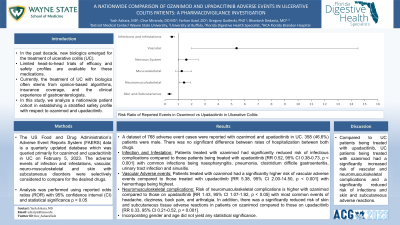Monday Poster Session
Category: IBD
P2118 - A Nationwide Comparison of Ozanimod and Upadacitinib Adverse Events in Ulcerative Colitis Patients: A Pharmacovigilance Investigation
Monday, October 23, 2023
10:30 AM - 4:15 PM PT
Location: Exhibit Hall

Has Audio

Yash P. Ashara, MBBS
Mayo Clinic
Rochester, MN
Presenting Author(s)
Yash P. Ashara, MBBS1, Clive J. Miranda, DO, MS2, Farhan Azad, DO2, Gregory D. Gudleski, PhD2, Bhavtosh Dedania, MD3
1Mayo Clinic, Rochester, MN; 2University at Buffalo, Buffalo, NY; 3HCA Florida Brandon Hospital, Brandon, FL
Introduction: In the past decade, new biologics emerged for the treatment of ulcerative colitis (UC). Limited head-to-head trials of efficacy and safety profiles are available for these medications. Currently, the treatment of UC with biologics often stems from opinion-based algorithms, insurance coverage, and the clinical experience of gastroenterologists. In this study, we analyze a nationwide patient cohort in establishing a stratified safety profile with respect to ozanimod and upadacitinib.
Methods: The US Food and Drug Administration’s Adverse Event Reports System (FAERS) data is a quarterly updated database which was queried primarily for ozanimod and upadacitinib in UC on February 5, 2023. The adverse events of infection and infestations, vascular, neuromusculoskeletal and skin with subcutaneous disorders were selectively considered to compare for the desired drugs. Analysis was performed using reported odds ratios (ROR) with 95% confidence interval (CI) and statistical significance p < 0.05
Results: A dataset of 768 adverse event cases were reported with ozanimod and upadacitinib in UC. 358 (46.6%) patients were male. There was no significant difference between rates of hospitalization between both drugs. Patients treated with ozanimod had significantly reduced risk of infectious complications compared to those patients being treated with upadacitinib [RR 0.52, 95% CI 0.38-0.73, p < 0.001] with common infections being nasopharyngitis, pneumonia, clostridium difficile gastroenteritis, urinary tract infection and sinusitis. However, patients treated with ozanimod had a significantly higher risk of vascular adverse events compared to those treated with upadacitinib [RR 5.38, 95% CI 2.00-14.50, p < 0.001] with hemorrhage being highest. Risk of neuromusculoskeletal complications is higher with ozanimod compared to those on upadacitinib [RR 1.43, 95% CI 1.07-1.92, p < 0.05] with most common events of headache, dizziness, back pain, and arthralgia. In addition, there was a significantly reduced risk of skin and subcutaneous tissue adverse reactions in patients on ozanimod compared to those on upadacitinib [RR 0.33, 95% CI 0.21-0.52, p < 0.001]. Incorporating gender and age did not yield any statistical significance.
Discussion: Compared to UC patients being treated with upadacitinib, UC patients being treated with ozanimod had a significantly increased risk of vascular and neuromusculoskeletal complications and a significantly reduced risk of infections and skin and subcutaneous adverse reactions.

Disclosures:
Yash P. Ashara, MBBS1, Clive J. Miranda, DO, MS2, Farhan Azad, DO2, Gregory D. Gudleski, PhD2, Bhavtosh Dedania, MD3. P2118 - A Nationwide Comparison of Ozanimod and Upadacitinib Adverse Events in Ulcerative Colitis Patients: A Pharmacovigilance Investigation, ACG 2023 Annual Scientific Meeting Abstracts. Vancouver, BC, Canada: American College of Gastroenterology.
1Mayo Clinic, Rochester, MN; 2University at Buffalo, Buffalo, NY; 3HCA Florida Brandon Hospital, Brandon, FL
Introduction: In the past decade, new biologics emerged for the treatment of ulcerative colitis (UC). Limited head-to-head trials of efficacy and safety profiles are available for these medications. Currently, the treatment of UC with biologics often stems from opinion-based algorithms, insurance coverage, and the clinical experience of gastroenterologists. In this study, we analyze a nationwide patient cohort in establishing a stratified safety profile with respect to ozanimod and upadacitinib.
Methods: The US Food and Drug Administration’s Adverse Event Reports System (FAERS) data is a quarterly updated database which was queried primarily for ozanimod and upadacitinib in UC on February 5, 2023. The adverse events of infection and infestations, vascular, neuromusculoskeletal and skin with subcutaneous disorders were selectively considered to compare for the desired drugs. Analysis was performed using reported odds ratios (ROR) with 95% confidence interval (CI) and statistical significance p < 0.05
Results: A dataset of 768 adverse event cases were reported with ozanimod and upadacitinib in UC. 358 (46.6%) patients were male. There was no significant difference between rates of hospitalization between both drugs. Patients treated with ozanimod had significantly reduced risk of infectious complications compared to those patients being treated with upadacitinib [RR 0.52, 95% CI 0.38-0.73, p < 0.001] with common infections being nasopharyngitis, pneumonia, clostridium difficile gastroenteritis, urinary tract infection and sinusitis. However, patients treated with ozanimod had a significantly higher risk of vascular adverse events compared to those treated with upadacitinib [RR 5.38, 95% CI 2.00-14.50, p < 0.001] with hemorrhage being highest. Risk of neuromusculoskeletal complications is higher with ozanimod compared to those on upadacitinib [RR 1.43, 95% CI 1.07-1.92, p < 0.05] with most common events of headache, dizziness, back pain, and arthralgia. In addition, there was a significantly reduced risk of skin and subcutaneous tissue adverse reactions in patients on ozanimod compared to those on upadacitinib [RR 0.33, 95% CI 0.21-0.52, p < 0.001]. Incorporating gender and age did not yield any statistical significance.
Discussion: Compared to UC patients being treated with upadacitinib, UC patients being treated with ozanimod had a significantly increased risk of vascular and neuromusculoskeletal complications and a significantly reduced risk of infections and skin and subcutaneous adverse reactions.

Figure: Risk Ratio of Reported Events in Ozanimod vs Upadacitinib in Ulcerative Colitis
Disclosures:
Yash Ashara indicated no relevant financial relationships.
Clive Miranda indicated no relevant financial relationships.
Farhan Azad indicated no relevant financial relationships.
Gregory Gudleski indicated no relevant financial relationships.
Bhavtosh Dedania indicated no relevant financial relationships.
Yash P. Ashara, MBBS1, Clive J. Miranda, DO, MS2, Farhan Azad, DO2, Gregory D. Gudleski, PhD2, Bhavtosh Dedania, MD3. P2118 - A Nationwide Comparison of Ozanimod and Upadacitinib Adverse Events in Ulcerative Colitis Patients: A Pharmacovigilance Investigation, ACG 2023 Annual Scientific Meeting Abstracts. Vancouver, BC, Canada: American College of Gastroenterology.
